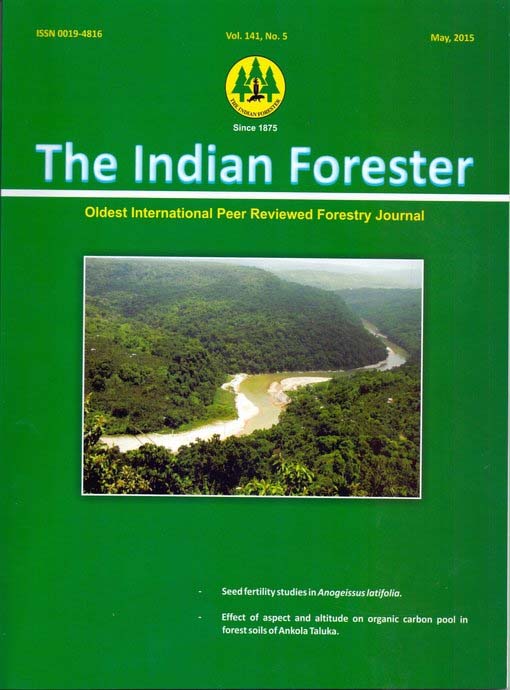Tree Species Assessment at Lohgad and Visapur Fort - A Part of Western Ghats, Maharashtra (India)
DOI:
https://doi.org/10.36808/if/2015/v141i5/70252Keywords:
Lohgad-Visapur Fort, Tree Checklist, Western Ghats, India.Abstract
During the present investigations, tree species were documented from Lohgad and Visapur forts which occupy a small geographical area in Western Ghats (one of the important global biodiversity hotspots and UNESCO'SWorld heritage site) near Lonavala and Khandala hill stations. Tree species were identified and number of families, genera and species were recorded along with their endemic and threatened status. Literature survey was made as a source of secondary data for comparative account. In all 194 tree species belonging to 134 genus and 48 families were recorded. Moraceae was dominant family followed by Mimosaceae and Euphorbiaceae. Twenty six non-native cultivated species were recorded. From the results it is concluded that, Lohgad-Vispur forts region is highly diverse but under the anthropogenic threats due to various developmental projects (irresponsible tourists, construction of roads and other infrastructure) and introduction of non-native species. Due to rich diversity and well-nourished habitat for the wildlife, this region was proposed for Santapau Wildlife Sanctuary. If protected well, it could be the corridor and nourishing habitat for wildlife of the area.References
CBD (1993). Convention on Biological diversity, United Nations- Treaty series, vol. 1760, no. 30619, Article 7,
Hejda M., Petr P. and Vojtech J. (2009). Impact of invasive plants on the species richness, diversity and composition of invaded communities, Journal of Ecology, 97:393-403.
HLWG. (2013). Report of the High Level Working Group on Western Ghats. Vol. I, Ministry of Environment and Forests, Government of India.
IIRS. (2002). Biodiversity Characterization at Landscape Level in Western Ghats India Using Satellite Remote Sensing and Geographic Information Systems. Indian Institute of Remote Sensing. National Remote Sensing Agency, Department of Space, Government of India. Dehra Dun.
Joshi V.N. and Kumbhojkar M.S. (1997), Floristic study on Vetal Hills and its adjacent hills in Greater Pune Area, Journal of Economic & Taxonomic Botany, 21(3): 507-529.
Krishnamurthy K.V. (2003). An Advanced Textbook on Biodiversity-Principles and Practice. Oxford & IBH Publ. Co. Pvt. Ltd., New Delhi. Kulkarni O.K., Kumbhojkar M.S. and Vartak V.D, (1989). Floristic studies on the Pachgaon Parvati hill near Pune, Journal of Economic & Taxonomic Botany, 13(1): 117-155.
Moreton Bay Regional Council (2008). A key to identifying local gum trees. PO Box 5070. Strathpine Qld 4500. www.moretonbay.qld.gov.au
Myers N., Mittermeier R.A., Mittermeier C.G., Fonseca G. and Kent J. (2000). Biodiversity hotspots for conservation priorities, Nature, 403: 853–858.
Pande S., Vishwasrao V., Sant N. and Deshpande P. (2008). Birds of Lonavala and Khandala. Ela Foundation and TATA Power Ltd., Pune.
Ramesh B.R. and Pascal J.P. (1997). Atlas of endemics of the Western Ghats (India): Distribution of tree species in the evergreen and semievergreen forests. French Institute of Pondicherry, Pondicherry.
Ravan S., Kale M. and Roy P.S. (2004). Identification of potential sites for in situ conservation of landraces associated with forest ecosystem- Geomatics approach, Current Science, 87(8): 1115-1122.
Razi B.A. (1952). Some aspects of vegetation of Poona and neighbouring districts, Journal of Poona University (Science & Technology), 1(2): 1-57.
Reddy C.S., Pattanaik C., Dhal N.K. and Biswal A.K. (2006). Vegetation and floristic diversity of Bhitarkanika National Park, Orissa, India, Indian Forester, 132 (6): 664-680.
Santapau H. (1957). The flora of Purandar. Oxford University Press, New Delhi.
Santapau H. (1967). The Flora of Khandala on the Western Ghats of India Records of the Botanical Survey of India. Vol. XVI, No.1. Botanical Survey of India, Calcutta.
Sharma B.D., Karthikeyan S. and Singh N.P. (1996). Flora of Maharashtra (Monocot). Botanical Survey of India, Calcutta.
Singh N.P. and Karthikeyan S. (2000). Flora of Maharashtra State, Dicotyledons Vol.-1, (Ranunculaceae to Rhizophoraceae). Botanical Survey of India, Calcutta.
Singh N.P., Lakshminarasimhan P., Karthikeyan S. and Prasanna P.V. (2001). Flora of Maharashtra state Dicotyledons Vol.-2, (Combretaceae to Ceratophyllaceae). Botanical Survey of India, Calcutta.
The Royal Botanic Gardens and Domain Trust (2013). Plant NET - The Plant Information Network System of The Royal Botanic Gardens and Domain Trust, Sydney, Australia http://plantnet.rbgsyd.nsw.gov.au/
Varadpande D.G. (1974). The Flora of Ganeshkhind, Poona, Journal of Poona University (Science & Technology), 44: 97-133.
Vartak V.D. (1959). Some edible wild plants from hilly region of Poona, Bombay State, Journal of Bombay Natural History Society, 56(1): 1-18.
Vartak V.D. (1960). The study of the flora of the Katraj Ghat, Journal of Poona University (Science & Technology), 22: 85-117.
Venkatreddi B. (1968). The flora of Sakharpathar & Ambavane region of Pune District –I, Bulletin of Botanical Survey of India, Vol.-II, No 1 & 2.
Venu P. (1998). A review of floristic diversity inventory and monitoring methodology in India, PINSA, B 64, 5 & 6: 281-292.
WGEEP (2011). Report of Western Ghat Ecological Expert Panal Part 1, submitted to Ministry of Environment and Forests, Govt. of India, New Delhi.
Downloads
Downloads
Published
How to Cite
Issue
Section
License
Unless otherwise stated, copyright or similar rights in all materials presented on the site, including graphical images, are owned by Indian Forester.





